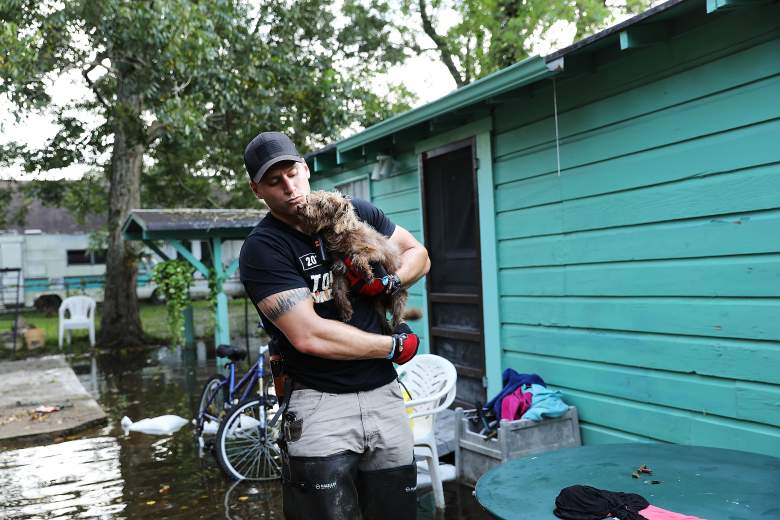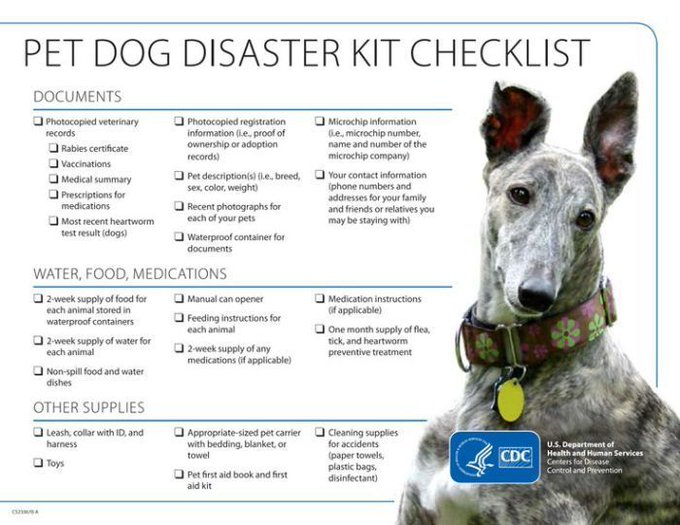
Getty How to keep your pets and furbabies safe during a hurricane or natural disaster.
As Hurricane Florence finally makes landfall, thousands of residents in the area have been preparing for Florence’s destruction by stocking up on water and emergency supplies, boarding up windows, and evacuating.
However, every time a major hurricane hits, those in the affected areas are also left scrambling to figure out what to do with their pets. Many hotels don’t allow evacuees fleeing a hurricane to bring their pets with them to hotels, so many are left with the incredibly difficult decision to abandon their pets while they flee or to ride out the storm with their furbabies by their side. Although many hotels are changing their policies to allow evacuees to bring their pets with, this is still a major issue that many face while preparing for natural disasters.

ORANGE, TX – SEPTEMBER 05: Matt Murray, a volunteer with an animal rescue organization, carries a small dog he found abandoned beside a flooded home on September 5, 2017, in Orange, Texas. Thousands of pets and livestock have either run away or been left to fend for themselves after Hurricane Harvey ravaged parts of the state of Texas. (Photo by Spencer Platt/Getty Images)
Unfortunately, thousands of people were faced with this choice during Hurricane Harvey, and thousands more are facing it again with Florence. For those who can’t bear the thought of leaving their furbabies behind, there are many things that can help pet owners keep pets safe during hurricanes and natural disasters.
Dr. Nick Saint-Erne, DVM, PetSmart’s resident veterinarian and pet care expert shared a few tips with Heavy to help ensure pet owners have everything they need to remain safe during Hurricane Florence, and any future natural disasters.
- Ensure your pets are safely contained. When severe weather warnings go into effect, crate or kennel your animals. Consider getting a pet carrier if you don’t already have one, and practicing crate training in advance to avoid extra stress in the face of an emergency. These are easy solutions to keep your dog or cat contained and ready to travel at a moment’s notice. Also, have buckets or plastic bins with a lid on hand for fish and turtles in the event you need to evacuate them – this is a safer alternative than transporting these pets in glass bowls or aquariums.
- Look for pet-friendly housing options for your pet should you need to evacuate your home. Ensure your pet is up-to-date on vaccinations, which are often needed for boarding, and that you have a supply of your pet’s medication. Be sure to have your pet’s medical records on file and on-hand. Ask friends, relatives and others outside of your immediate area whether they could shelter your animals. Prepare a list of animal shelters, boarding facilities and veterinarian offices that could shelter animals during an emergency, and include 24-hour phone numbers.
- Make sure your pet has identification. Countless pets go missing after storms. Proper ID on your pet is the best assurance you and your pet are reunited in the event you are separated. “Consider microchip identification for your pets, as this is a permanent way to identify them. All rescue groups and veterinarians can check lost pets for microchip identification,” Saint-Erne said. “After a disaster, if you have lost your pet, post you pet’s information on websites that are designed to help reunite lost pets with their owners. It’s also a good idea to check to see if your pet may have been dropped off at the local humane association.”
- Be aware of “paw-level” hazards post-storm. Sharp debris, toxic spilled chemicals, fertilizers and other substances on the floor of the home or ground outside may pose less risk to upright humans, but can be dangerous to ground-level pets. Downed power lines from hurricanes and high water from floods can also pose a threat for animals after a disaster. Take the time to consider the dangers your pet will face before entering into an area, home, shelter or other building.
- Provide comfort. Severe weather can be frightening to pets. Provide your dog or cat with a familiar toy or blanket or try aids like calming sprays, collars, chews, supplements or a ThunderShirt™ to help ease anxiety.
- Assemble a pet disaster supply kit. Create a pet safety kit, including the following, in an easy-to-carry waterproof container that can be taken during storms, fires, earthquakes and evacuations.
- Portable food and water bowls, along with a one-week supply of food and fresh water
- Hard copies of each pet’s updated vaccination records
- An extra supply of medication (if refrigeration is necessary, have easy access to a small, insulated bag or cooler)
- First-aid items such as antiseptic spray, antibacterial ointment and liquid bandage products. These are easy solutions that can deliver quick first-aid care in the event of a pet injury
- A list of regional pet-friendly hotels
- A bed, carrier or leash and harness for each animal
- Pet waste bags
- Cat litter, litter box and scoop
- Current photos and descriptions of your pets, in case they get lost
For additional pet safety tips and resources, visit PetSmart’s Learning Center or speak with an in-store PetSmart associate.
READ NEXT: President Trump Tweets & Reactions to Hurricane Florence
